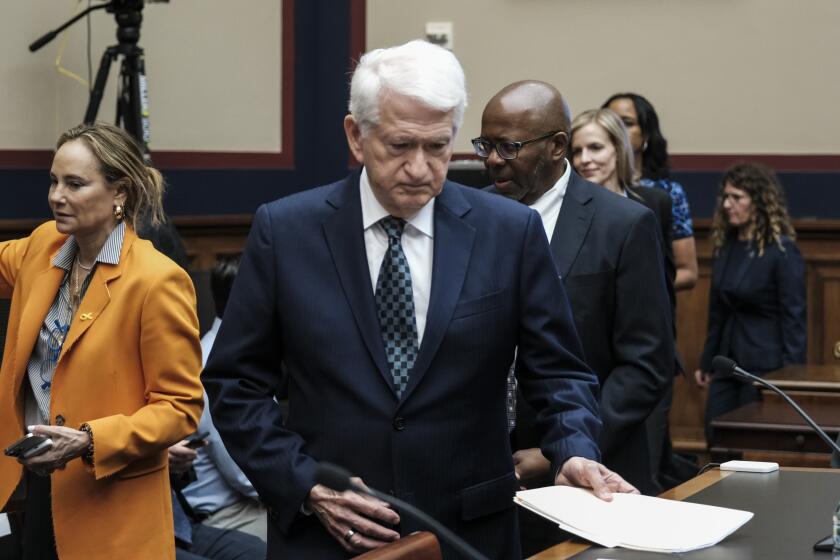New School District Boundaries May Become Battle Lines : Education: Redistricting could trigger a power shift on school boards. Lines have to be redrawn to conform with new census data.
The contentious issues of boosting nonwhite voting power and eliminating at-large voting face trustees on both the San Diego city schools and community colleges governing boards as they begin to redraw their election districts.
Reapportionment has traditionally been considered an in-house exercise by school boards, with the process in past decades gathering little attention and thus little public participation compared to that of local and state legislative bodies.
But the process this time around is sure to draw more interest because San Diegans reflect increased nationwide concern that education is failing to prepare for the nation’s future and because of dramatic changes in the city’s demographics.
The changing ethnic numbers, in particular the growth in the Latino population, could mean extensive redrawing of at least one district, or creation of one or two new ones, to increase the chances of electing a Latino or other nonwhite representative in the 1992 elections.
Further, the decision two years ago by city voters to eliminate the City Council’s at-large voting places pressure on the two education boards to take a similar step. The boards still use the two-step procedure where candidates run within their individual districts in a primary, and the two top vote-getters then compete in a citywide runoff covering voters in all five trustee districts.
City schools trustees on Tuesday will consider how to meet a January 11, 1992 deadline for redrawing the boundaries of their five existing districts. The date is the last day for potential candidates to enter the race for three trustee seats on the June 1992 ballot. Schools attorney Tina Dyer said that the board must act to redraw boundaries for the first election after receiving final United States Census data. The government finalized that data last week.
(The districts for both the city schools and community colleges closely resemble each other in geographical size and population because both educational systems operate under the same election provisions of the San Diego city charter. Two community college seats will be up for election in June 1992.)
Supt. Tom Payzant is recommending that the board hire a demographics consultant to draw up some choices for evening out population numbers among the districts and hold public hearings before any board action. Because of the political sensitivity involved--incumbents naturally want to have districts redrawn to enhance, or at least maintain, their ability to win re-election--Payzant does not want his own staff drawing new boundaries for their bosses.
Right now, the proportion of residents making up each district varies by up to 5 percentage points. District A now has 167,360 residents in the northwest portion of the city; District E has 209,564 residents in the southeast area. In 1980, each of the districts had approximately 20% of the entire school district’s population.
In addition, District E used to be about 46% Anglo 31% Black and 25% Latino in 1980. But under the 1990 Census, the number of Latinos surpassed the number of blacks; the district now is 34% Anglo, 34% Latino and 26% Black. The seat has been held by a Black for the past 29 years.
The Anglo percentage in the other four districts remains about 70% or higher in the new census. There has never been a Latino member of the school district board, although the Community College district does now have a Latino representative.
The San Diego city charter would have to be amended if board members wish to change the method of electing trustees by going to a district-only contest, and/or to increase the number of trustee seats to make individual districts smaller.
A majority of the present city schools trustees favors district-only elections, although a previous board in 1989 rejected proposing such a charter amendment by arguing that citywide runoffs force trustees to consider the interests of all city students and not just those from their particular geographical area.
The board’s position on expanding the number of seats is less clear, based on a preliminary discussion that trustees held in February 1991.
Proponents argue that additional districts would enhance racial and ethnic representation by creating smaller areas with larger numbers of nonwhite residents. They also could be based on high-school attendance boundaries as a way to boost parent interest and participation.
Opponents dislike the idea of creating ethnic-bloc districts and of increasing the administrative costs of running a board with seven members.
If one or more charter amendments were placed before district voters in June 1992 and approved, trustees then would run in 1994 under the new procedures.
Payzant would like the community college trustees to join in the process because the two districts operate under the same election procedures of the charter.
Augustine Gallego, community college chancellor, has spoken with Payzant and agrees that a joint reapportionment effort would make sense. However, he said that his own board must consider all the ramifications, adding that the issue of expanding the number of seats from five to seven “could be sensitive.”
A different community college board voted in 1989 to support a charter amendment eliminating at-large runoffs, putting it in opposition to the city school board at the time. In part because of the conflicting positions, the San Diego Charter Review Commission in that year voted not to put an amendment on the ballot asking voters to make such a change.
More to Read
Start your day right
Sign up for Essential California for news, features and recommendations from the L.A. Times and beyond in your inbox six days a week.
You may occasionally receive promotional content from the Los Angeles Times.






